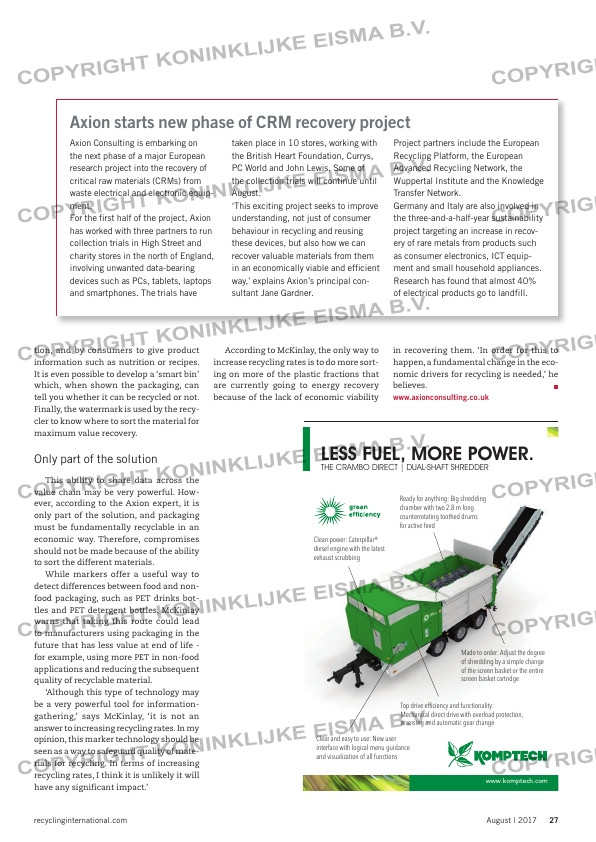Page 29 from: Edition 5 2017

27August | 2017recyclinginternational.com
tion, and by consumers to give product
information such as nutrition or recipes.
It is even possible to develop a ‘smart bin’
which, when shown the packaging, can
tell you whether it can be recycled or not.
Finally, the watermark is used by the recy-
cler to know where to sort the material for
maximum value recovery.
Only part of the solution
This ability to share data across the
value chain may be very powerful. How-
ever, according to the Axion expert, it is
only part of the solution, and packaging
must be fundamentally recyclable in an
economic way. Therefore, compromises
should not be made because of the ability
to sort the different materials.
While markers offer a useful way to
detect differences between food and non-
food packaging, such as PET drinks bot-
tles and PET detergent bottles, McKinlay
warns that taking this route could lead
to manufacturers using packaging in the
future that has less value at end of life –
for example, using more PET in non-food
applications and reducing the subsequent
quality of recyclable material.
‘Although this type of technology may
be a very powerful tool for information-
gathering,’ says McKinlay, ‘it is not an
answer to increasing recycling rates. In my
opinion, this marker technology should be
seen as a way to safeguard quality of mate-
rials for recycling. In terms of increasing
recycling rates, I think it is unlikely it will
have any significant impact.’
According to McKinlay, the only way to
increase recycling rates is to do more sort-
ing on more of the plastic fractions that
are currently going to energy recovery
because of the lack of economic viability
in recovering them. ‘In order for this to
happen, a fundamental change in the eco-
nomic drivers for recycling is needed,’ he
believes.
www.axionconsulting.co.uk
Axion starts new phase of CRM recovery project
Axion Consulting is embarking on
the next phase of a major European
research project into the recovery of
critical raw materials (CRMs) from
waste electrical and electronic equip-
ment.
For the first half of the project, Axion
has worked with three partners to run
collection trials in High Street and
charity stores in the north of England,
involving unwanted data-bearing
devices such as PCs, tablets, laptops
and smartphones. The trials have
taken place in 10 stores, working with
the British Heart Foundation, Currys,
PC World and John Lewis. Some of
the collection trials will continue until
August.
‘This exciting project seeks to improve
understanding, not just of consumer
behaviour in recycling and reusing
these devices, but also how we can
recover valuable materials from them
in an economically viable and efficient
way,’ explains Axion’s principal con-
sultant Jane Gardner.
Project partners include the European
Recycling Platform, the European
Advanced Recycling Network, the
Wuppertal Institute and the Knowledge
Transfer Network.
Germany and Italy are also involved in
the three-and-a-half-year sustainability
project targeting an increase in recov-
ery of rare metals from products such
as consumer electronics, ICT equip-
ment and small household appliances.
Research has found that almost 40%
of electrical products go to landfill.
Ready for anything: Big shredding
chamber with two 2.8 m long
counterrotating toothed drums
for active feed
Clean power: Caterpillar®
diesel engine with the latest
exhaust scrubbing
Clear and easy to use: New user
interface with logical menu guidance
and visualization of all functions
Top drive ef ciency and functionality:
Mechanical direct drive with overload protection,
reversing and automatic gear change
Made to order: Adjust the degree
of shredding by a simple change
of the screen basket or the entire
screen basket cartridge
LESS FUEL, MORE POWER.
THE CRAMBO DIRECT | DUAL-SHAFT SHREDDER
www.komptech.com



